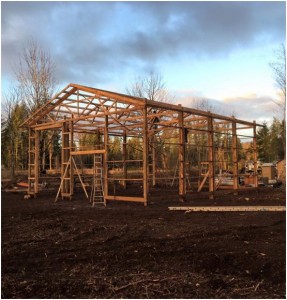I always give credit “where credit is due” and my next subject is supported by the online writings of a Professional Engineer, Mr. Harris Hyman. He wrote about frost as far back as July 1994 in Practical Engineering, Like Mr. Hyman, I too like to dig down deep into why some problem is caused, before I figure out the solution. Today and far into the future, frost heaves are just one of those things we need to be aware of, and plan buildings, (pole buildings or otherwise) accordingly.
This is what Mr. Harris Hyman, P.E. had to say:
 As an engineer, I want to understand a little about the problem before I recommend corrective measures. Research work on frost heaving is somewhat limited, but there is a theory. Around the end of winter in cold regions, the earth develops a characteristic temperature profile: At the surface, the earth takes on the day’s temperature. But a couple of inches below, the ground temperature cools to approximately the February average temperature of the region. As we go deeper into the earth, the temperature rises, until several feet deep it reaches the annual mean temperature of the area.
As an engineer, I want to understand a little about the problem before I recommend corrective measures. Research work on frost heaving is somewhat limited, but there is a theory. Around the end of winter in cold regions, the earth develops a characteristic temperature profile: At the surface, the earth takes on the day’s temperature. But a couple of inches below, the ground temperature cools to approximately the February average temperature of the region. As we go deeper into the earth, the temperature rises, until several feet deep it reaches the annual mean temperature of the area.
The soil usually reaches its coldest temperature in March, when the freezing point reaches down to the region’s frost line. Below this depth, the soil and groundwater almost never freeze. But at the frost line — the 32°F point — the groundwater freezes, forming a thin sheet of ice. In soils that are porous enough to allow moisture to move, more groundwater touches this ice. The groundwater accumulates, freezes, and builds up into a bulge called an ice lens, which might be anywhere from several inches to a few feet across. The bulging ice lens pushes the earth above up into a frost heave. Aggravating the effect is surface melting, which also occurs at the end of March. The snow melt water moves through the ground, touches the ice lens, and adds to the bulge.
This is why, every spring, rural roads up North develop sinuous dips and dives. The ice lenses form during the winter, pushing up spots on the asphalt surface. When the weather warms sufficiently to melt the ice lenses, the unsupported asphalt sags and leaves low spots and potholes. On major highways, which cost a lot more to build, the base layer is sufficiently permeable to carry away groundwater, so heaves are rare.
Let’s take a break here, reflect on this a bit and what it might mean to pole buildings – the ice lens pushing up on asphalt concept – means it can also push up on buildings at the frost line. Come back tomorrow to hear more of what Mr. Hyman may have to say on the subject of frost heaves.






